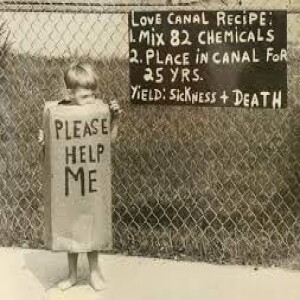
On this day in labor history, the year was 1978.
That was the day President Jimmy Carter declared a federal health emergency at Love Canal, in the city of Niagara Falls, New York.
Premier spokeswoman, housewife Lois Gibbs became the poster child for the citizen environmental justice movement virtually overnight.
Niagara Falls Gazette journalists broke the story two years earlier.
Their sump pump testings and health surveys found a number of toxic chemicals and unusually high rates of cancers, birth defects, miscarriages and other serious health concerns.
Initially planned as a canal, the site remained abandoned until the 1940s.
That’s when Hooker Electrochemical Plant and the City began using the site to dispose of toxic chemical and municipal waste.
More than 20,000 tons of toxic sludge containing more than 21,000 chemicals were buried there.
Then, in 1953, the City School Board bought the site and built two schools on the property.
Soon, about 1,000 families settled nearby.
By the early 70s, residents complained of foul odors, health issues, substances filling their basements and leaky waste disposal drums popping up in back yards, killing all plant life.
Class and racial tensions soon emerged among working class white homeowners and black renters, both of whom sought compensation and relocation.
Carter’s initial declaration provided limited funding.
But the disaster led to the passage of the Superfund Act.
The neighborhood was demolished and residents were compensated and relocated.
The new owner of Hooker Chemical, Occidental Petroleum settled with the EPA for $129 million.
Despite 21 years of remediation and residential redevelopment, new residents complained in 2011 of foul odors and ruptured sewage lines oozing toxic sludge.
By 2014, 1,000 new complaints had been filed contending the area had never been properly remediated.
More Episodes
 2023-12-16
2023-12-16
 2023-12-16
2023-12-16
 2023-12-12
2023-12-12
 2023-12-12
2023-12-12
 2023-12-10
2023-12-10
 2023-12-09
2023-12-09
 2023-12-07
2023-12-07
 2023-12-05
2023-12-05
 2023-12-05
2023-12-05
 2023-12-05
2023-12-05
 2023-12-02
2023-12-02
 2023-12-01
2023-12-01
 2023-11-28
2023-11-28
 2023-11-27
2023-11-27
Create your
podcast in
minutes
- Full-featured podcast site
- Unlimited storage and bandwidth
- Comprehensive podcast stats
- Distribute to Apple Podcasts, Spotify, and more
- Make money with your podcast
It is Free
- Privacy Policy
- Cookie Policy
- Terms of Use
- Consent Preferences
- Copyright © 2015-2024 Podbean.com




